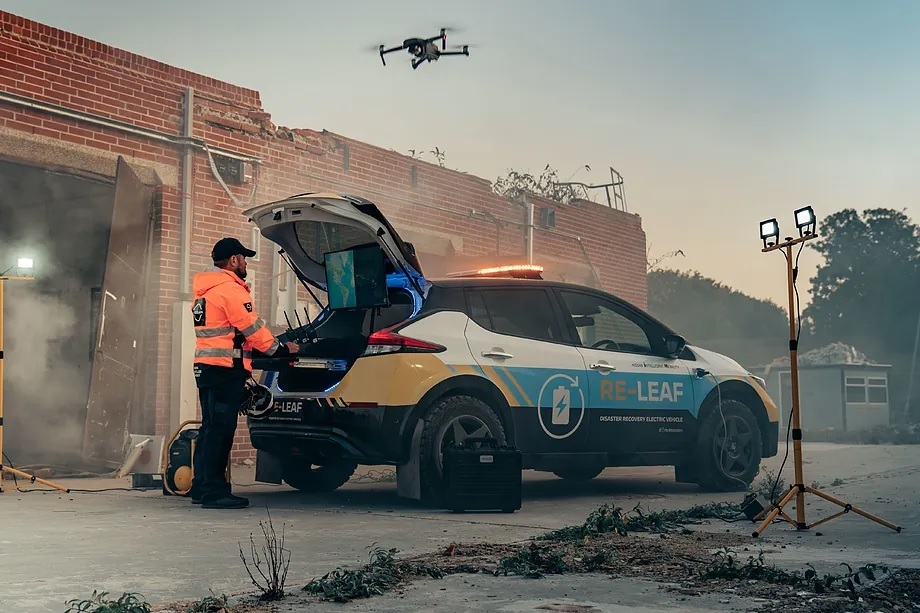When last Monday Spain experienced a complete blackout due to a total electricity supply failure, many thought that having a battery-powered car would have been the perfect solution, impossible to recharge. Just as true as gas stations were also blocked, some owners of these types of vehicles did (or could have done) basic - and important today - things like charging their phone or computer; or turning on a lamp and even cooking something on a portable electric grill.
The key lies in V2L technology (Vehicle to Load), the simplest application of the so-called bidirectional charging. This means that the car, in addition to storing energy, can exchange it with the outside world. In this case, to power small appliances or external devices or even recharge another vehicle.
V2L Charging: Increasingly Common
Nissan implemented it in the Leaf in 2011, many years later, Kia and Hyundai began offering it in models like the EV6 or the Ioniq 5, both high-end, but it is starting to reach cheaper cars. Even in compact cars like the new Renault 5 and 4 E-Tech, the BYD Atto 2, or the Hyundai Inster which is reviewed in these pages.
Technically, it is very simple. It is enough to convert the energy from the battery from direct current to alternating current and have a plug adapted for the device we want to connect. Furthermore, it does not depend on external adaptations or the legislation of each country, which is the case with more advanced developments of bidirectional charging: V2H (Vehicle to Home), which allows exchanging electricity with our home; and V2G (Vehicle to Grid) when it is possible to connect the car to the power grid.
More than five days of household consumption
Regarding V2H, statistics indicate that the average consumption of a Spanish household is about 9 kWh per day, 270 per month, and just over 3,300 kWh per year. This means that a car with a battery of about 50 kWh - a small size compared to what is already available - would allow, roughly calculated, our house to continue operating for more than five days without limitations. Or many more if we do without non-essential consumption.
Finally, V2G charging would even have implications at the country level. We can think of thousands of batteries (and kWh) connected to the power grid so that it would be possible to store excess electricity generated, especially from wind or solar sources, which are more difficult to control. Or feed it back into the grid when there is low production. In other words, it would be a tool that would help stabilize the system, adjusting supply and demand. A disruption of this balance is precisely what caused the blackout last Monday: in just a few seconds, 15 gigawatts were lost, equivalent to 60% of national consumption. That is why there is a European project to use electric vehicles for this purpose.
There are also advantages for the user. They could benefit from charging the car battery only with renewable energies or when electricity is cheapest and then get paid for returning it to the grid when needed. In the Netherlands and England, customers who lease their car batteries under this scheme earn between 800 and 1,000 euros per year, according to Nissan, which also points out that most cars are parked up to 95% of the time.
However, these contracts are not allowed in Spain. And there are also limitations. For example, in the case of V2H, it is much easier if we have a single-family home, like a villa. And in any of the described scenarios, we subject the battery to many more cycles, which will reduce its lifespan. Finally, all the electricity we use for these purposes will not be available for driving the car.
In this sense, Nissan designed a prototype called Re-Leaf in 2020, with a 62 kWh battery and prepared to provide electrical supply in case of natural disasters. Along with climate change, these were responsible for 37% of power outages in Europe between 2000 and 2017, and 44% in the US according to the World Bank. In fact, the brand introduced its first electric car (the 2011 Leaf) precisely as a kind of mobile energy hub after the famous earthquake that occurred a year earlier in Japan.
Additionally, in 2018, the Japanese company implemented a energy storage system at the Johan Cruyff Arena in Amsterdam, Netherlands, consisting of 148 car batteries (85 new and 63 used), with a total power of 3 Megawatts. This allows lighting the stadium with energy from the 4,200 solar panels on the roof, or storing excess energy during low demand periods. In Spain, similar projects are being carried out with Melilla by Endesa; or with Acciona in Navarra.
